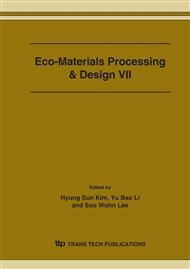p.650
p.654
p.658
p.662
p.666
p.670
p.674
p.678
p.682
Effect of Hydrogen Content on Characteristics of Cu/C: H Films Coated on Polyethylene Terephthalate Substrate Prepared by ECR-MOCVD Coupled with a Periodic DC Bias
Abstract:
Cu/C:H films were prepared on the PET (polyethylene terephthalate) substrate under room temperature by ECR (electron-cyclotron-resonance) chemical vapor deposition coupled with a (-)DC bias system. Hydrogen contents in the plasma strongly affected the crystallographic structures, sheet resistivity, and the composition of deposited films. Cu (111) peaks by XRD analysis were clearly observed with the increase of hydrogen contents. The surface morphology also indicated that copper grains of very fine crystallites were incorporated in the metal-organic composite films by the introduction of hydrogen gas to the plasma. Cu/C:H composite films exhibited a good adhesion force due to the generation of sp3-CH2 bonding. These observations imply that hydrogen induced the formation of stable volatile organic compounds and the reduction of copper, consequently leading to a significant alteration of the crystallographic structure and composition of deposited films. Finally, the EMI shielding efficiency was increased by the addition of hydrogen gas to the plasma, probably due to the increase of copper contents in the film.
Info:
Periodical:
Pages:
666-669
Citation:
Online since:
March 2006
Authors:
Keywords:
Price:
Сopyright:
© 2006 Trans Tech Publications Ltd. All Rights Reserved
Share:
Citation:


